Arrr-g Matey! Sailing the Code Seas with Args and Kwargs: A Pirate's Guide to Function Adventure!
 JMN
JMN
In Python, we have two handy ways to pass arguments to functions: args and kwargs. Args is like a basket where you can put any number of arguments without naming them, while kwargs is like a basket where you can put named arguments. We use them when we are not sure how many arguments we need to pass to a function.
Args
As noted, the special syntax *args in Python function definitions is used to pass a variable number of arguments to a function. This allows you to pass a list of positional arguments of any length without specifying their names explicitly
Example 1
First, let's create a simple function where we shall just add two numbers together.
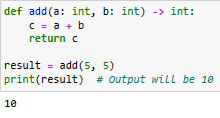
This is a simple function that I think is self-explanatory. To understand more about functions, see my article here: https://hashnode.com/post/clrwfyk9k00050al1gdia1leo
Suppose you want to modify the add function to accept a variable number of arguments. In the provided example, let's attempt to call the add function with three arguments:
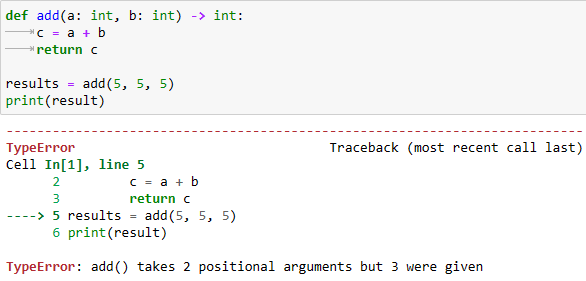
The add function is defined to only accept two arguments (a and b). When you try to pass three arguments (5, 5, 5), Python raises an error because the function is not designed to handle this situation.
To address this issue, you can utilize the *args parameter, which allows the function to accept any number of positional arguments. Let's modify the add function to achieve this:
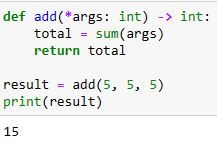
By using *args, you can pass any number of arguments to the add function, and it will sum them up correctly. In this case, it will output 15 since it adds up all the arguments provided (5 + 5 + 5). This approach aligns with the concept of Python's *args, which liberates one from the conventional practice of confining oneself to a predetermined number of positional arguments.
Example 2
It is possible to think that you have to name your args variable the same as args, but this is not true. You can name the variable anything you like, as long as you precede it with a single asterisk (*). This is shown in the example below:
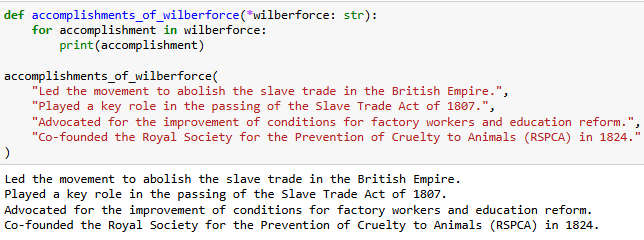
First, we define function named
accomplishments_of_wilberforceThe
*wilberforceparameter allows the function to accept any number of positional arguments. These arguments will be collected into a tuple namedwilberforceThe
: strannotation suggests that the arguments should be stringsThe
-> Nonepart indicates that this function does not return a valueThe
forloop function iterates over each item in thewilberforcetupleFor each item in the tuple, it prints the item (accomplishment)
Call the
accomplishments_of_wilberforcefunction with four string argumentsThese arguments/accomplishments are packed into the
wilberforcetuple inside the functionFinally, the function is called, it will print each accomplishment on a new line
Kwargs
The special syntax **kwargs is utilized to pass a variable-length argument list consisting of keyworded arguments. Unlike *args, which captures non-keyworded arguments into a tuple, **kwargs employs the double star to facilitate the passing of keyword arguments, allowing for any number of them. These keyword arguments are collected into a dictionary named kwargs (or any other specified name), where each argument becomes a key-value pair. Thus, while *args collects positional arguments, **kwargs enables the handling of keyword arguments in a dictionary format.
Example 1
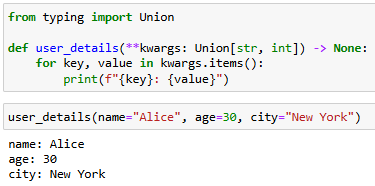
Before we delve into the code, I want to clarify that it's not strictly necessary to include Union[str, int] in the **kwargs syntax or specify -> None to indicate that the function does not return anything, or even import Union from typing. Omitting these would not affect the functionality of the code; it's simply a matter of personal preference. However, I prefer to include type hints and specify the return type for clarity and consistency in my code.
First, let us define a function named
user_detailsthat accepts keyword arguments (**kwargs)The
Union[str, int]type hint specifies that the values of the keyword arguments can be either strings or integersInside the function, it iterates over each key-value pair in the
kwargsdictionary and prints them.When we call the function with the provided keyword arguments (
name="Alice",age=30,city="New York"), it prints the details accordingly.
Example 2

The function
create_user_profileis defined with the**profile_detailsparameter, which indicates that it accepts any number of keyword argumentsThe type hint
Union[str, int]specifies that the values of the keyword arguments can be either strings or integersThe return type hint
-> dictindicates that the function returns a dictionary.Inside the function, a dictionary named
profileis constructed to hold the user profile detailsThe
get()method is used to retrieve the value associated with each key in theprofile_detailsdictionary. If a key is not found, a default value is provided (e.g., 'Guest' for 'username', 'Not provided' for 'email', and 'N/A' for 'first_name' and 'last_name')The constructed user profile dictionary
profileis returned from the functionThe function
create_user_profileis called with keyword arguments specifying various details of the user profile for "user1", such as 'username' and 'first_name'These details are passed to the function as keyword arguments
The user profile dictionary
user1is printed to display the user profile details
And that concludes our exploration of the special *args and **kwargs syntax in Python. I trust that you, dear reader, have gained valuable insights from this discussion. In our next article, we'll delve into the world of Python user input and discover how it seamlessly integrates with the power of *args and **kwargs. Stay tuned for more exciting insights and practical tips. Until then, happy coding!
Subscribe to my newsletter
Read articles from JMN directly inside your inbox. Subscribe to the newsletter, and don't miss out.
Written by

JMN
JMN
I'm JMN (Jaffery Mwangi Ndisho), and I'm thrilled to share my passion for data analytics and programming with you. With a background in business and IT, I've always been fascinated by the power of algorithms and their ability to transform data into insights. Through this blog, I hope to share my learning journey and practical knowledge with you, as well as explore new techniques and applications in the field. Join me on this journey and let's discover the world of data analytics and programming together!